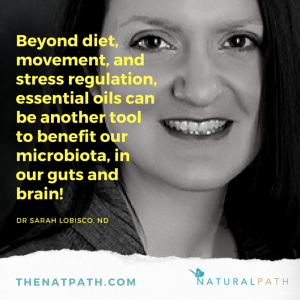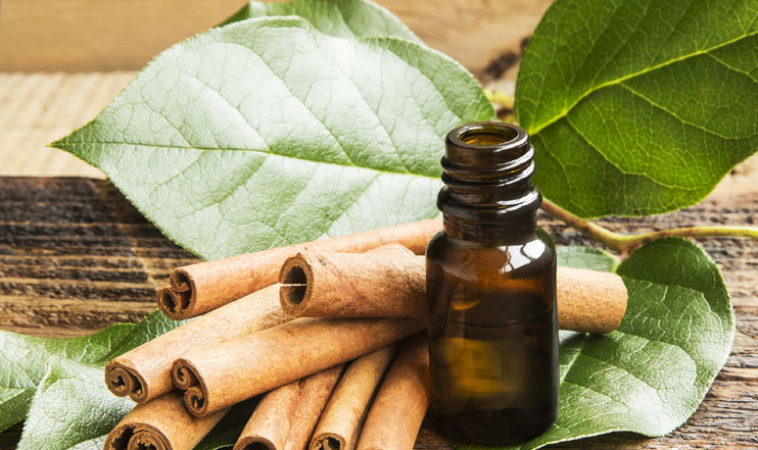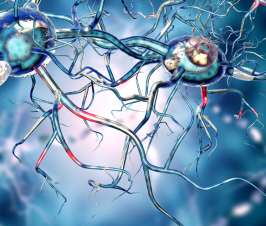 In part I of this blog, I discussed several ways that autumn embraces us with its aromas for health and well-being. The smells of fall are intricately connected to the volatile compounds known as essential oils. They have powerful immune supporting properties and support the body, mind, and spirit in various ways.
In part I of this blog, I discussed several ways that autumn embraces us with its aromas for health and well-being. The smells of fall are intricately connected to the volatile compounds known as essential oils. They have powerful immune supporting properties and support the body, mind, and spirit in various ways.
I also gave a general overview on the topic of the microbiome. This subject has become an obsession for health experts and researchers, and for good reason! As time passes, these critters that line our insides and outsides and communicate with our own cells are being shown to impact almost every disease process. Microbes are also being discovered in organs previously deemed to be pathogen- free. It appears being sterile from the start isn’t necessarily a good thing, or even true!
How does this relate to essential oils?
Beyond diet, movement, and stress regulation, essential oils can be another tool to benefit our microbiota, in our guts and brain! In this blog, I want to discuss how the bugs in our lungs may be another mechanism on how the healing scents of fall keep us healthy throughout the seasons.
Your Non-Sterile Lungs
Recently, I’ve been seeing more studies on the microbiome of our lungs 1-7and how it is connected to respiratory health. Just as the belief that we started off with sterile bellies is being overturned, it appears that our lungs are buggier than we previously thought.
As we discover more about the role of microbes in health and disease, they seem to be “popping up” in the most unexpected places. Perhaps this is due to the fact that we now have better tools of discovery to find them.
An article in JAMAreports:3
The word microbiome has become a catch term only in the past decade, but it refers to something as old as humanity itself: the diverse and unimaginably vast population of microorganisms that share our bodies. These microbiota compose an ecosystem whose constituent cells and genes actually outnumber our own, and without which we would be unable to carry out many functions necessary for life. Medicine has succeeded in mapping much of the gut microbiome, but only recently has advanced technology enabled researchers to identify and study the inhabitants of the human respiratory system and possibly use this information to diagnose and treat respiratory disease.3
A 2016 article from theEuropean Respiratory Journal also states the importance of this newly discovered habitat for critters:4
Since the 1980s, new microbial identification techniques have demonstrated that respiratory airways, long regarded as sterile, contain different pathogen communities, known as the lung microbiome [3]. Microbiomes, formerly called microbial flora, corresponds to all bacteria, viruses, fungi and other microorganisms in the human body. In healthy subjects, the total number of bacteria in the lung tissue has a density of 10–100 per 1000 human cells, which is relatively low compared with the gut flora [4]. Microbiomes play a crucial role in the development and integrity of the immune system. If certain bacteria are essential in the development of a healthy immune system, the modification of the lung microbiome can lead to diseases (figure 1) [5].
Compared with the abundant literature on the gut microbiome, the studies of lung microbiome or microbiota associated with the inception, loss of control and severity of chronic airway disorders are gradually leading to more reports in our respiratory journals [6].4
An overview of the lung microbiome and some of its findings in relationship to various disease processes such as cystic fibrosis, asthma, and allergies can be found on the Life Science website here.5
Essential Oils for Our Buggy Lungs
Essential oils could be a tool to modulate the lung microbiome due to several factors.
- Essential oils effect physiology, psychology, and biochemical processes through their role as secondary metabolites and the influence of their aroma. They have already been shown to positively modulate respiratory and immune health through their active constituents.
- There is evidence that essential oils can keep the helpful microbes around and selectively inhibit the pathogenic ones.
- Essential oils are used for oral care, which is influential on our lung microbiome.6-7 Below are a few articles on the oral care using essential oils:
What does all this mean?
Sniffing essential oils, and using them for oral care, may not only be beneficial for lung health due to the aroma and constituents, but because these constituents are influencing the balance of bugs in our lung microbiome. Due to the fact that the lung microbiome has an impact on our gut microbiome,6-7 the connections to our overall bug population could be endless!
Now, we can really “breathe” in the benefits of fall smells and enjoying the spicy odors of some of our favorite pumpkin-spiced beverages with a healthy smile!
References:
- Morris A, Flores S. Study of the Lung Microbiome. Have We Reached the End of the Beginning? [abstract]. AJRCCM [online]. January 2017; 195(1). Available at: https://doi.org/10.1164/rccm.201608-1635ED
- Dickson RP, Erb-Downward JR, Huffnagle GB. The Role of the Bacterial Microbiome in Lung Disease. Expert Review of Respiratory Medicine. 2013;7(3):245-257. doi:10.1586/ers.13.24.
- Lyon J. The Lung Microbiome: Key to Respiratory Ills?. JAMA. 2017;317(17):1713–1714. doi:10.1001/jama.2017.3023
- Gomez C, Chanez P. The lung microbiome: the perfect culprit for COPD exacerbations? European Respiratory Journal. Apr 2016; 47(4): 1034-1036. DOI: 10.1183/13993003.00270-2016
- Robertson S. The Lung Microbiome. Life Sciences [Website]. May 12, 2017. Available at: https://www.news-medical.net/life-sciences/Lung-microbiome.aspx. Accessed October 31, 2017.
- Dickson RP, Huffnagle GB. The Lung Microbiome: New Principles for Respiratory Bacteriology in Health and Disease. PLoS Pathog; 2015. 11(7): e1004923. https://doi.org/10.1371/journal.ppat.1004923
- O’Dwyer DN, Dickson RP, Moore BB. The Lung Microbiome, Immunity and the Pathogenesis of Chronic Lung Disease. Journal of immunology (Baltimore, Md : 1950). 2016;196(12):4839-4847. doi:10.4049/jimmunol.1600279.
Image Copyright: <a href=’https://www.123rf.com/profile_marrakeshh’>marrakeshh / 123RF Stock Photo</a>
 Dr. Sarah LoBisco, ND, is a graduate of the University of Bridgeport’s College of Naturopathic Medicine (UBCNM). She is licensed in Vermont as a naturopathic doctor and holds a Bachelor of Psychology from State University of New York at Geneseo. Dr. LoBisco speaks professionally on integrative medical topics, has several journal publications, and has completed her postdoctoral training as a certified functional medicine practitioner. Dr. LoBisco currently incorporates her training in holistic medical practices and conventional medicine through writing, researching, private wellness consultations, and through her independent contracting work for companies regarding supplements, nutraceuticals, essential oils, and medical foods. Dr. LoBisco also enjoys continuing to educate and empower her readers through her blogs and social media. Her recent blogs about living naturally in our complex world and on the applications of essential oils can be found at www.dr-lobisco.com and at www.saratoga.com/living-well. Her new book BreakFree Medicine is now available on Amazon and Barnes & Noble’s.
Dr. Sarah LoBisco, ND, is a graduate of the University of Bridgeport’s College of Naturopathic Medicine (UBCNM). She is licensed in Vermont as a naturopathic doctor and holds a Bachelor of Psychology from State University of New York at Geneseo. Dr. LoBisco speaks professionally on integrative medical topics, has several journal publications, and has completed her postdoctoral training as a certified functional medicine practitioner. Dr. LoBisco currently incorporates her training in holistic medical practices and conventional medicine through writing, researching, private wellness consultations, and through her independent contracting work for companies regarding supplements, nutraceuticals, essential oils, and medical foods. Dr. LoBisco also enjoys continuing to educate and empower her readers through her blogs and social media. Her recent blogs about living naturally in our complex world and on the applications of essential oils can be found at www.dr-lobisco.com and at www.saratoga.com/living-well. Her new book BreakFree Medicine is now available on Amazon and Barnes & Noble’s.

















